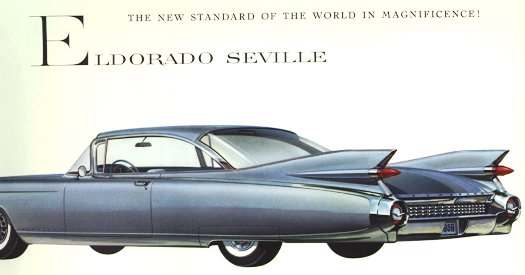Streamlining and Fashion
Today, thoughts on streamlining and fashion -- high culture and pop culture. The University of Houston's College of Engineering presents this series about the machines that make our civilization run, and the people whose ingenuity created them.
Years ago I poked fun at streamlined, tail-finned American cars from the '50s. A local writer called to object: Maybe those cars looked funny, he said, but they were some of the finest automobiles ever built. Our conversation has gone on ever since.
Later, he introduced me to work by the controversial author Camille Paglia. Last night, both streamlining and Paglia suddenly resurfaced. First, a librarian lent me a new book, Streamlined: The Esthetics of Minimized Drag. Then, as I thumbed the book, I glanced up and saw Paglia talking on the TV.
First, the book: it reminds us that the aim of streamlining is to reduce turbulent drag in the flow of air or water around a body. Good streamlining makes it easier to propel a vehicle.
But what looks like streamlining doesn't always mean less drag. The streamlining fad did more to catch our imaginations than it did to speed travel. Engineers often forgot that wind tunnel tests don't apply to a vehicle moving along a stationary road. And, for supersonic jets, streamlining rules change utterly. Streamlining is complicated. It's all too easy to confuse its purpose with styles that only hint at that purpose.
Same point in Paglia's talk: Someone asked, "Don't fashion magazines promote a kind of woman invented by men?" Her answer: Sure, the shifting ideals of high fashion have little to do with real women or real clothing. But fashion isn't what drives women to anorexia and bulimia. What fashion really does is offer strong visual images to people who wouldn't normally savor pop culture. It offers an excuse for grooving on visual excess.
So, in both cases, function is replaced by an odd energizing force. We see that at work in the TV series Star Trek. The old series gave us the miniskirted, big-hair fashion of the '60s. The starship Enterprise also had the tailfins of a '50s Cadillac. The show was a perfect mirror for 1960s pop culture.
Clothes in the new Star Trek series are as eclectic as today's fashions. Now we also understand that, where there's no air, there need be no streamlining. Starship architecture begins to mirror the static avant-garde buildings on Earth's surface.
But what's constant -- in both the dress and the form of the space vehicles -- is energy! You and I have fed off Star Trek's raw energy since we were young. Whatever you think of Paglia, fashion, or streamlining, they all remind us that high culture flows from pop culture. Pop culture has always been the well where we draw our energy. It's hardly the place to look for useful clothing or efficient travel. What it really is -- is the place we go to recharge our batteries.
I'm John Lienhard at the University of Houston, where we're interested in the way inventive minds work.
(Theme music)
Streamlined: A Metaphor for Progress (The Esthetics of Minimized Drag) (Claude Lichtenstein and Franz Engler, eds.). Baden, Switzerland: Lars Muller Publishers, no date given.
Paglia, C., Sexual Personae: Art and Decadence from Nefertiti to Emily Dickinson. New Haven: Yale University Press, 1990.
Howell, J.W. and Howell, J.S., Cadillac Eldorado. Osceola, WI: Motorbooks International, 1994.
I am grateful to Margaret Culbertson, UH Art and Architecture Library, for suggesting the Streamlined book and to Bill and Jeanna Howell for their thoughts on Paglia, streamlining, and 1950s American automobiles. See also Episode 96 on streamlining.

The 1959 Cadillac Eldarado Seville
From an expensive Cadillac mailout brochure, with permission of Bill Howell